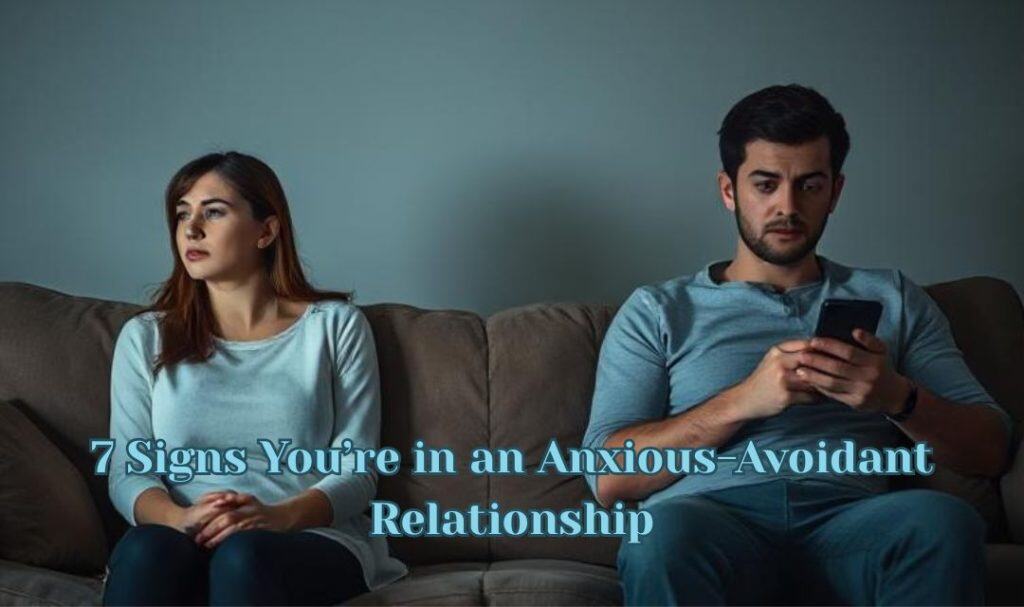You fall for someone. You feel chemistry. Then the confusion begins. They’re hot one moment, cold the next. You’re trying harder; they’re pulling away. Welcome to the anxious-avoidant attachment relationship, a psychological pattern where emotional closeness and distance clash.
If you’re navigating a partnership where intimacy feels like a chase, you’re not alone. This cycle can feel impossible to escape, especially if you’re unsure what’s driving it. In this article, we break down seven telltale signs you’re stuck in an anxious-avoidant relationship, and what you can do to reclaim your emotional clarity and power.
1. You’re Constantly Anxious About Where You Stand
The emotional inconsistency in an anxious avoidant relationship can trigger attachment anxiety that gnawing feeling of not knowing if you’re wanted, loved, or secure.
- Example: Your partner texts for days, then goes silent for a week. You spiral into overthinking.
- Why It Matters: Anxious partners often seek closeness, but avoidants withdraw when they sense pressure. It’s a dissonance of intimacy needs.
Action Tip: Start documenting your emotional responses. Use journaling or self-help tools to observe patterns objectively before reacting emotionally.
2. You Feel Like You’re “Too Much” or “Too Needy”
Avoidantly attached partners often shut down or get distant when confronted with emotional intimacy. Over time, their behavior may condition you to question your worth.
- Subtle Manipulation: You ask for reassurance, and they call it clingy. You express your feelings, and they get defensive.
- Emotional Impact: You may begin to suppress your needs to maintain peace, a trauma bond in disguise.
What to Do Next: Learn to validate your own needs. Start reading evidence-based relationship and mental health books like those in Rick Bryant’s library, especially if you’re recovering from childhood attachment wounds.
3. There’s Intimacy, Then Withdrawal
This is one of the classic signs of the anxious-avoidant trap. One moment, you’re sharing deeply. The next, your partner becomes emotionally unavailable, distant, or even critical.
- Pattern Recognition: Does intimacy lead to a disappearing act? That’s not random, it’s avoidant behavior.
- Cycle Consequences: You may begin to associate closeness with loss, a trauma pattern often misread as “chemistry.”
Healing Strategy: Set emotional boundaries. Consistency is a requirement, not a request. If they can’t meet that, it may be time to rethink the relationship.
4. You’re Reading Articles Like This One (Often)
If you’re consistently googling, “Why do I feel insecure in my relationship?” or “Am I in an anxious-avoidant relationship?”, that’s not by chance.
- Self-Awareness = Power: Your search signals are your subconscious trying to solve what your conscious mind can’t.
- Cross-Link: Many individuals trapped in toxic attachment patterns also battle obsessive thought cycles, a symptom often explored in obsessive compulsive disorder books like Rick Bryant’s Break Free from Your OCD.
Next Step: Don’t just consume content, take action. Seek coaching, therapy, or a structured self-help framework grounded in attachment theory.
5. You Walk on Eggshells to Avoid Triggering Them
When you become overly attuned to your partner’s moods or fears of abandonment, you’re not in a secure relationship, you’re in a codependent survival dance.
- What You Sacrifice: Your voice, emotional needs, and authenticity.
- Avoidant Traits: Your partner might avoid confrontation, shut down emotionally, or weaponize silence.
Emotional Reset: It’s not your job to regulate their discomfort with intimacy. Start focusing on what you need to feel safe, seen, and supported.
6. You Can’t Picture a Future, But Can’t Let Go
Do you daydream about a different version of your partner who “finally gets it”? Do you feel stuck, not because of love, but out of emotional dependency?
- Avoidant Reality: Avoidant partners often struggle to commit or plan long-term, not because they don’t care, but because closeness feels threatening.
- Anxious Reality: Anxious types cling to hope, idealizing moments of connection while ignoring long-term instability.
Grounding Exercise: Write two lists:
- How they make you feel at your best
- How they make you feel at your worst
If the latter list is longer, it’s time for radical honesty.
7. You’re Losing Yourself
Perhaps the biggest sign you’re trapped in an anxious-avoidant cycle is the sense that you’ve become a version of yourself you barely recognize, anxious, reactive, walking on emotional landmines.
- Symptoms: Increased anxiety, overthinking, compulsive checking, rumination.
- Parallel Mental Health Concerns: Many people in anxious-avoidant dynamics exhibit symptoms overlapping with obsessive-compulsive behavior or trauma responses.
Self-Repair: Return to self-care basics. Create routines, read empowering mental health books, build identity beyond the relationship. Rick Bryant’s Break Free from Your OCD is a great place to reconnect with self-trust.
What You Can Do Now: Break the Cycle, Reclaim Your Power
Acknowledge Your Attachment Style
Self-awareness is the first step toward healing. Learn about attachment theory, identify your tendencies, and understand your partner’s behavior without blaming yourself.
Commit to Inner Work
Healing from an anxious-avoidant relationship isn’t about fixing the other person. It’s about becoming secure within yourself. That may mean working with a trauma-informed therapist, or reading books like those in Rick Bryant’s catalog that empower emotional autonomy.
Detach from the Fantasy
It’s easy to fall in love with someone’s potential. But transformation only happens when both people are committed to growth. If you’re the only one doing the work, it’s not a relationship, it’s a rescue mission.
Final Thoughts: You Deserve Emotional Safety
Breaking free from an anxious-avoidant relationship doesn’t mean you failed. It means you’ve finally chosen emotional safety over emotional chaos.
The journey to emotional independence takes courage, but you don’t have to walk it alone. Rick Bryant’s writing bridges the gap between psychological insight and real-life healing. Whether you’re healing from toxic relationships or managing obsessive-compulsive patterns, your journey matters, and recovery is possible.

